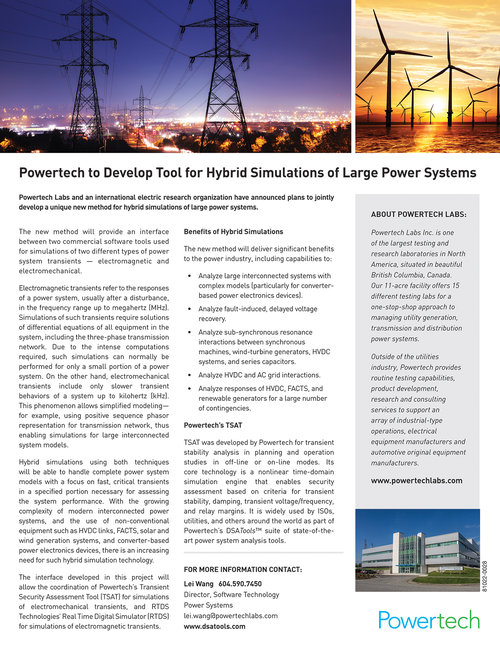
Powertech Labs and an international electric research organization have announced plans to jointly develop a unique new method for hybrid simulations of large power systems.
The new method will provide an interface between two commercial software tools used for simulations of two different types of power system transients — electromagnetic and electromechanical.
Electromagnetic transients refer to the responses of a power system, usually after a disturbance, in the frequency range up to megahertz (MHz). Simulations of such transients require solutions of differential equations of all equipment in the system, including the three-phase transmission network. Due to the intense computations required, such simulations can normally be performed for only a small portion of a power system. On the other hand, electromechanical transients include only slower transient behaviors of a system up to kilohertz (kHz). This phenomenon allows simplified modeling—for example, using positive sequence phasor representation for transmission network, thus enabling simulations for large interconnected system models.

Hybrid simulations using both techniques will be able to handle complete power system models with a focus on fast, critical transients in a specified portion necessary for assessing the system performance. With the growing complexity of modern interconnected power systems, and the use of non-conventional equipment such as HVDC links, FACTS, solar and wind generation systems, and converter-based power electronics devices, there is an increasing need for such hybrid simulation technology.
The interface developed in this project will allow the coordination of Powertech’s Transient Security Assessment Tool (TSAT) for simulations of electromechanical transients, and RTDS Technologies’ Real Time Digital Simulator (RTDS) for simulations of electromagnetic transients.
Benefits of Hybrid Simulations
The new method will deliver significant benefits to the power industry, including capabilities to:
- Analyze large interconnected systems with complex models (particularly for converter-based power electronics devices).
- Analyze fault-induced, delayed voltage recovery.
- Analyze sub-synchronous resonance interactions between synchronous machines, wind-turbine generators, HVDC systems, and series capacitors.
- Analyze HVDC and AC grid interactions.
- Analyze responses of HVDC, FACTS, and renewable generators for a large number of contingencies.
Powertech’s TSAT
TSAT was developed by Powertech for transient stability analysis in planning and operation studies in off-line or on-line modes. Its core technology is a nonlinear time-domain simulation engine that enables security assessment based on criteria for transient stability, damping, transient voltage/frequency, and relay margins. It is widely used by ISOs, utilities, and others around the world as part of Powertech’s DSATools™ suite of state-of-the-art power system analysis tools.
For more information contact:
Lei Wang
604.590.7450
Director, Software Technology
Power Systems
email→
www.dsatools.com
